Tragedy at MacDill AFB
Situated strategically four miles south of Tampa, Florida, at the end of a peninsula that separates Old Tampa Bay from Hillsborough Bay is MacDill Air Force Base. Established on May 24th, 1939, for the Army Air Corps, it was initially called Southeast Air Base, Tampa. The base has overseen a variety of missions that continue today. However, this article focuses on only a short period at the outbreak of World War II.
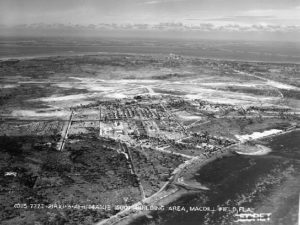
Southeast Air Base, Tampa (MacDill Field) under construction, June 1939
With the end of World War I in November of 1918, Germany began a slow and secret military rearming. The feeling the war wasn’t lost on the battlefield but that they had been “stabbed in the back” by civilian leaders who agreed to the armistice agreement was very prevalent. It was then that Adolph Hitler began his rise to power. By 1933 Hitler was named Chancellor of Germany, the number two position of power in the country. Because of infighting and struggles for power among the various political parties and acts of violence resulting from them, Hitler was given ultimate power with the passage of The Enabling Act that same year. The act allowed him to pass laws without the approval of Hindenburg or the vote of parliament. During four days the next year, in what became known as “The Night of the Long Knives,” Hitler’s Nazi Party members, SS, and Gestapo Police force, rounded up and killed all of the opposition party leaders in Germany with estimates of between 85 to as many as 400 people arrested and shot.
It was now that Germany’s military rearmament began in earnest and became visible to the outside world. The Great Depression in America affected the German economy negatively as well, so Hitler put people to work building his war machine. The only way to rebuild Germany, Hitler said, and guarantee its survival was to regain lands lost in the first world war and take lands to the east rich in raw materials and oil. While German engineers were designing new and improved ships, submarines, and aircraft for combat, American engineers focused on peacetime planning. Nothing demonstrated this better than in the field of aviation. The German Luftwaffe was developing medium and long-range bombers while America was designing civilian monoplane airliners. Before 1933, most American military was still flying bi-planes that were slower and less maneuverable. But when German rearmament became known, the world powers scrambled to catch up, America included.
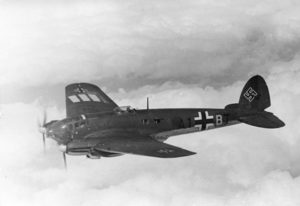
German Heinkel HE 111, a mid-range bomber designed in the early 1930s in violation of the Treaty of Versailles
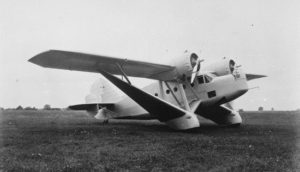
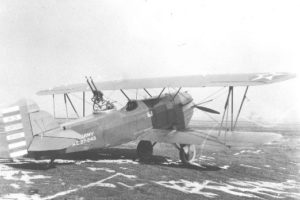
American Bellanca 77-140 Medium Bomber 1934 American Curtis A-3 Falcon 1924-1937
The development of the well-known B-17 Flying Fortress came from a request by the Army Air Corps in early 1934 and had its first test flight in 1935. A later version of the B-17 was only built in two groups of 40 planes, one in 1939 and 1940. Following more design changes and America formally entering the war in 1941, the B-17 model F/G that we know so well was built from an order of over 3,000, but not until 1942. We were very late to the game, and corners were cut. One of the most tragic played out here in Florida.
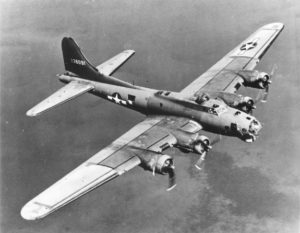
American B-17 F/G Flying Fortress 1942
In March of 1939, just six months before Hitler’s troops invaded Poland, the U.S. Army Air Corps put out another call, this time for a medium bomber to be developed. It would need to be fast, only have two engines, and be capable of carrying 2,000 pounds of bombs; essentially, a fighter-bomber that could reach speeds of 350 mph and have a range of 3,000 miles. The Glen L. Martin Company answered the call with their design of the B-26 Martin Marauder. The army was so impressed with the paper’s design; they purchased 206 planes without one plane built or tested.
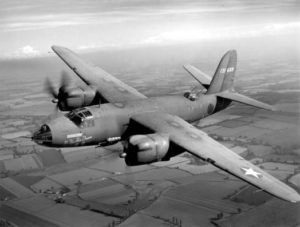
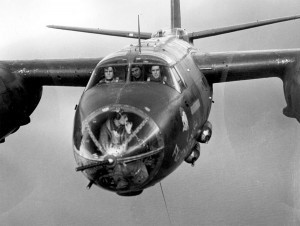
B-26 Martin Marauder
Eventually, the primary flight training center for Marauder crews would be MacDill Field in Tampa. But when the eager new pilots arrived and got their first look at their planes, there was disbelief. It had a fat, cigar-shaped fuselage, only two engines, and very short wings. As training proceeded, problems began to be realized, with one engine frequently failing on takeoff. Maintenance of the pitch control on the props attached to the two Pratt & Whitney engines was highly technical, and the new ground crews could not maintain them. Improper prop adjustment would cause the props to disintegrate at takeoff speeds. Upon the plane’s arrival, the army also began loading extra armament and plating onto it, which increased the aircraft’s weight beyond what was safe for the wing length and power plant capabilities. Many pilots were not accustomed to the high landing speed of 130-150 mph the Marauder required.
All of these issues combined caused a high fatality rate for the new bomber crews, which became so bad, the plane was given the nicknames “Widowmaker” and “Flying Coffin.” The phrase, “One a day in Tampa Bay,” was mumbled throughout air bases around the country. Pilots and crews began to apply for transfers in record numbers. Fifteen crashes in one thirty-day period happened at MacDill. Pilots didn’t believe the plane could be flown on one engine. The Army Air Corps brought in Colonel Jimmy Doolittle, famous for his B-25 raid over Tokyo, to prove it could be done. They also brought in 17 female “WASP” pilots to fly the plane to shame the male pilot’s fears.
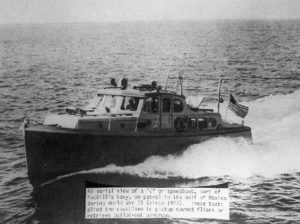
Patrol boats out of MacDill operated daily in the bay and Gulf of Mexico to pick up downed airmen
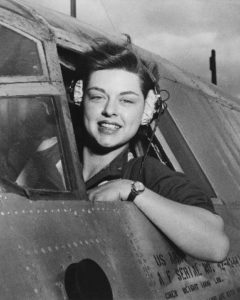
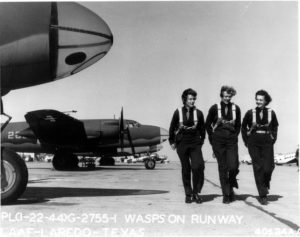
Women Airforce Service Pilots (WASP’s) flying the B-26 in Laredo, Texas
Ultimately, the Martin Company’s mechanics were brought to MacDill to train the ground crews caring for the aircraft. At the factory, three feet of length was added to each wing and the vertical stabilizer (tail). The nose landing gear, known to have a high failure rate, was improved. After these changes, the B-26 came into its own. With a crew of six, they served with distinction in every WWII theater, first in the South Pacific, then North Africa, and finally Europe. They flew at bombing altitudes of 10,000 to 15,000 feet, much lower than the heavy bombers, putting the B-26 at greater risk from enemy fighters and flak damage. But flying in tight formations of six planes for mutual protection and able to fly at higher speeds, the U.S. 9th Air Force reported their B-26 units as having the lowest loss rate of any aircraft flying in the European Theater.
The nightmare in Tampa Bay had come to an end. Finally flying out of bases in liberated France, the B-26 crews helped bring an end to the war by knocking out enemy supply lines deep in Nazi Germany, especially during the Battle of the Bulge in the winter of 1944-45. The “Widowmaker” came home a hero of the war, along with the crews that flew them, but many had given their lives in the process of making them flight worthy.
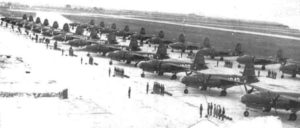
B-26 Flight Crew Inspection at MacDill Field
Most B-26 Marauders were destroyed at war’s end, so they are rare planes to find today. But you can see one of the few remaining at Fantasy of Flight Air Museum in Polk City, Florida, and you can get an up-close and personal look at the nose section of “Flak Bait” at the National Air & Space Museum in Washington, D.C. The B-26, the plane that made MacDill Field one of the most famous of the war.
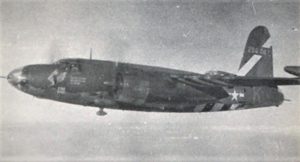
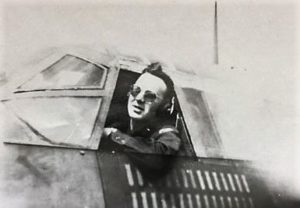
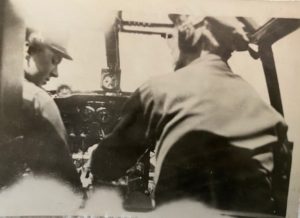
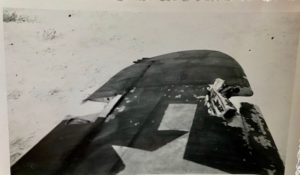
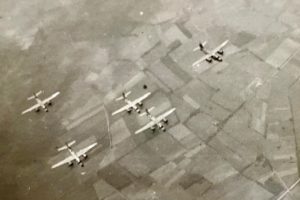
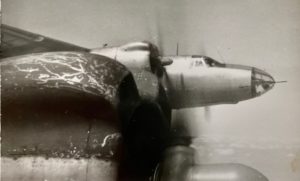
“Firebird,” (photo top left) a B-26 with the 394th Squadron flying out of Cambrai, France, piloted by my father-in-law, Major Willis “Bill” Huebner, over Germany during the Battle of the Bulge, December 1944. His unit was nicknamed the “Bridge Busters.” He would later belly-land this aircraft in low visibility after his nose gear was heavily damaged by enemy flak, saving his entire crew. The feat earned him the Distinguished Flying Cross. All of the photos on this page are from his personal collection. He piloted 38 missions in four different planes between October of 1944 and May of 1945. He then continued to fly supply missions with American post-war occupation forces between France and Germany before returning home to Strawberry Point, Iowa, to marry his high school sweetheart, Rosalee.
*All photos are in public domain
About the Author: Rick Cain
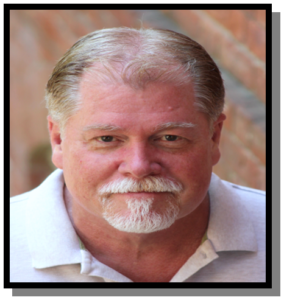

Rick Cain has worked for the St. Augustine Lighthouse & Maritime Museum for 18 years after a 20-year career as a health care professional.
He serves on the Board of Directors of the American Lighthouse Council and is Immediate Past Chair of the Florida Attractions Association. He also works closely with the United States Coast Guard to maintain their historical ties to the Museum.

